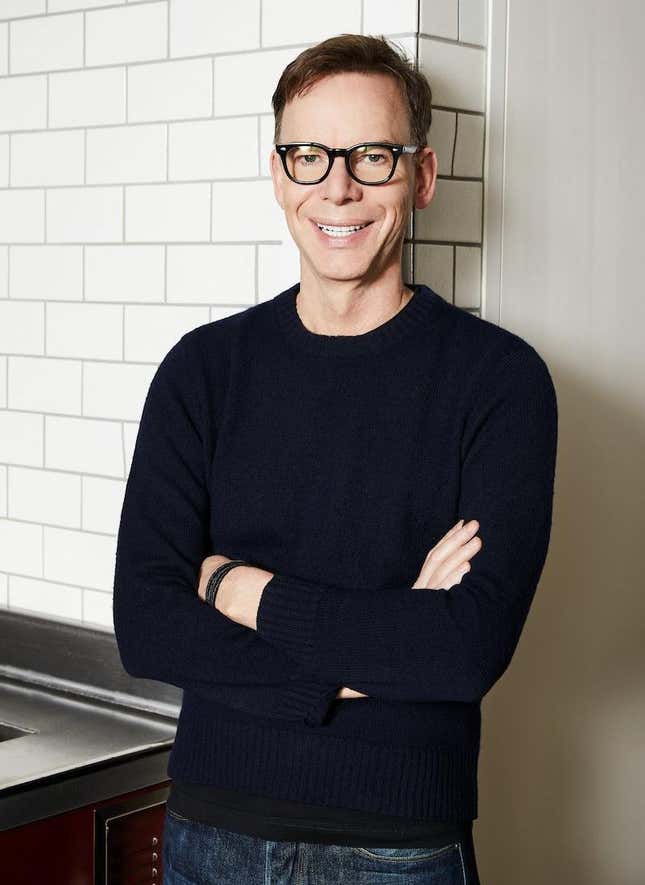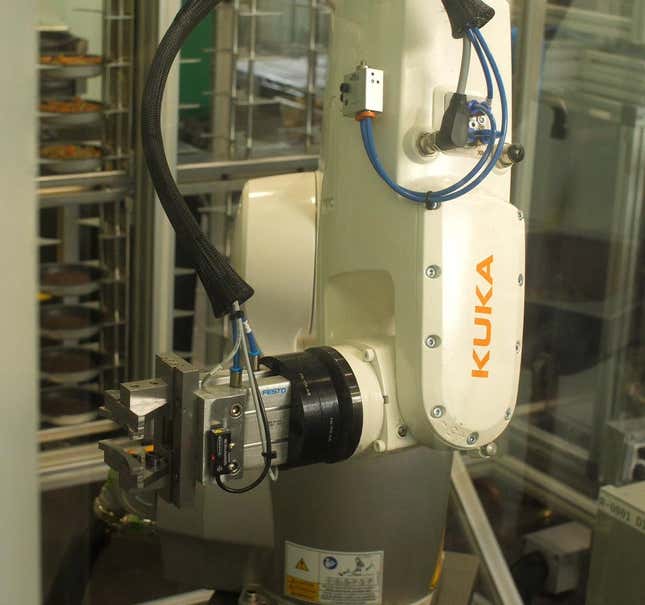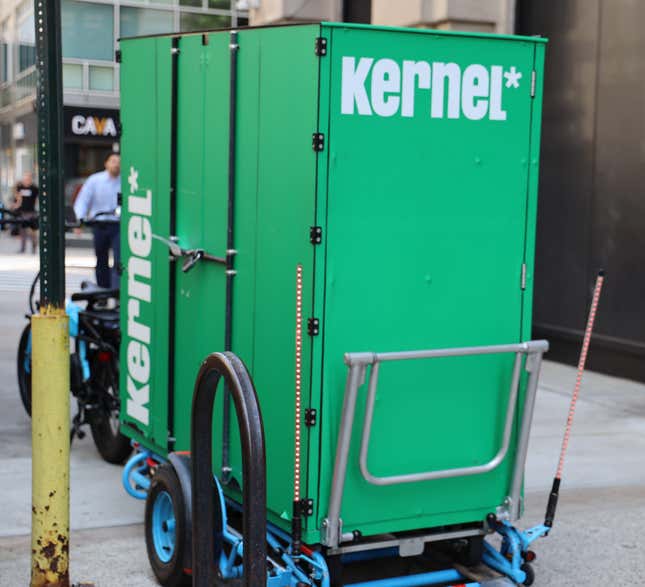
The Chipotle Founder’s New Recipe to Take Your Lunch Money
I’m leaning against a teal lunch counter with the sound of robots whirring behind me, and Steve Ells is telling me about “mise en place.” It’s French culinary lingo for the prep a chef does before cooking, translating to “everything in its place.” But the founder of Chipotle is describing himself, and the decades of experience that has prepared him to launch his newest automated lunch spot, Kernel. I guess you could say he’s about to cook.
Ells is ready to revolutionize fast food yet again. He’s no longer slinging burritos, but instead using robot arms, automated conveyor belts, and mobile apps to serve up plant-based burgers and intricate vegetable sides. His plant-forward restaurant Kernel (the restaurant was vegan at first, but now they’ve introduced some items with cheese and mayo) is somewhere between a tech platform and a fast food joint. Ells believes it’s the next big thing in lunch.
If anyone can reinvent fast food, it’s probably the guy who did it already. Since opening the first Chipotle 31 years ago, Ells went from a line cook in San Francisco to the pioneer of America’s “fast casual” restaurant craze. Despite his stint in the Bay Area, Ells does not have a technology background. But the founder of Chipotle is now channeling his inner tech bro, designing robot-powered restaurants that will require a minimal number of actual humans working. He describes Kernel as the next Chipotle, his latest quirky restaurant idea that might change everything.

Ells opened the first Kernel three months ago, right beside Madison Square Park in downtown Manhattan. Walking to the restaurant midday on a Tuesday, I pass by corporate lunch favorites like Sweet Green, Cava, and other fast casual spots brimming with hungry collared shirts. All these restaurants have the bare bones of a Chipotle, undoubtedly inspired by Ells’ legacy. But walking into Kernel, it looks nothing like them.
I’m greeted by a row of lockers, with an actual greeter standing off to the side explaining how to order off a QR code – there’s no person to take your order. Behind the lockers, three employees are assembling lunch orders beside a robot arm that’s been placed on oven duty. The robot veers around making calculated grabs at vegan burger patties, trays of potatoes, and crispy faux chicken. It cooks each one before passing it off to a human coworker. Conveyor belts pass buns to one employee and slip finished side dishes to another. The employees work within the automated system – like fleshy gears in a well-oiled machine – and you can’t help but wonder if they will be replaced by a robot one day, too.

According to Ells, that’s not off the table. For now, the few employees in the restaurant are paid incredibly well – better than any service job I’ve ever worked. Each Kernel employee makes $25 an hour and is offered health insurance, paid vacation, and potentially equity in the company (Ells says he’s committed to figuring that piece out). These employees supposedly get a good gig because there are so few of them.
While many might be skeptical of a robot taking the job of a fast food worker, Ells is more optimistic.
When speaking with Ells, he felt strongly that automation empowers Kernel’s employees, not disenfranchises them. In his eyes, the system solves the problem of the “McJob,” the fast food jobs that have come to be defined by terrible working conditions and low wages. Kernel allows cooks to do less monotonous work, and ultimately, be paid better because the entire operation is cheaper.
However, they’re not the only employees. Delivery wagons, called Llamas (shown on the right), are biked in from Kernel’s Central Kitchen, just six minutes away. Each is filled with food and once unloaded, they’ll get filled with dirty dishes and go back to the Central Kitchen. There, a small team of chefs is doing the prep work and dishwashing that allows Kernel to operate so cleanly.

Between the cooks at Kernel, prep chefs at the Central Kitchen, delivery people, and greeters, I counted about 11 employees working to keep one Kernel restaurant afloat on Thursday morning. Separately, there’s a team of programmers and engineers that upkeep the automated systems. That’s at least as many people working at a typical Chipotle, but the “magic” of Kernel happens at scale. Kernel is already opening its second skeleton crew restaurant in downtown Manhattan. At that point, two Kernels should require fewer employees than two Chipotles. By the time there are 20 Kernels, the hub and spoke model should enable it to grow rapidly with very few employees. That’s the billion-dollar idea, at least.
The food at Kernel is delicious, by my standards. The plant-forward menu aims to attract younger diners who are more health and environmentally conscious. My favorites were a plant-based chicken sandwich that could’ve fooled any meat eater. A cucumber side topped with chili jam, cashews, and fresh herbs showed me how Kernel’s attention to prep pays off. And Kernel’s vegan oatmeal raisin cookie has won me over. Ells says Kernel’s model can elevate fast food just like Chipotle did 31 years ago, and I have to say I agree.
Achieving true automation in the real world is easier said than done. We’ve seen countless failed experiments when introducing automation into uniquely human environments, such as a restaurant. Amazon pulled its Just Walk Out checkout technology from its grocery stores in April after reports that the system struggled to work fully autonomously. A company that offers AI drive-thru services to Chili’s and Carl’s Jr. reportedly required a human to help with 70% of its orders. The CEO of robotaxi company Cruise resigned shortly after one of his cars dragged a woman in San Francisco. The reason it’s so hard is because humans have a lot of variables, and automation struggles outside of controlled environments.
But Ells, like any good chef, brings control and order to chaotic environments. He says Kernel has worked through several bugs in the first few months. One example he gave was a robot arm that was moving too fast at the beginning, flinging potatoes around the room. Three months later, he says things are running pretty smoothly. As Kernel expands to more locations and attempts to automate more of its work, this may become more challenging. Currently, there doesn’t seem to be much AI involved, but moving forward it might have to.
Kernel is a genuine proposition to shake up the fast food world, from someone who knows it inside and out. I recently sat down with Ells to talk through his grand plan. We spoke about fast food’s evolution from the dollar menu, Chipotle’s origin story, and how automation could change lunch forever. Here’s what he had to say:
(This interview has been edited for clarity, consistency, and brevity.)
Maxwell Zeff, Gizmodo: Steve, we’re very excited to talk about Kernel. But first, before Kernel, before Chipotle, you were a sous chef under Jeremiah Tower, correct?
Steve Ells, Kernel: Well, I never made it to sous chef. I went from line cook to CEO. I skipped a bunch of stuff.
You skipped a lot of steps in there, most people have a couple more jobs in between. But when you worked there, it was a very famous institution in San Francisco led by an acclaimed chef. What inspired you about food and cooking when you started?
Well, I have been interested in food, cooking, and the table really, since I was a little kid. I watched cooking shows and I used to read my mom’s cookbooks and try to cook out of them – I just loved it.
By my college graduation, it seemed like everybody knew what they were doing, but I was not sure. And so one of my roommates said, “Steve, you should go to cooking school.” I was always cooking in the house and she knew it was my passion. So I looked into the Culinary Institute of America and went that fall.
Chipotle peppers, queso, and even burritos were not exactly household food items 30 years ago, but today they are. A large part of that is because of Chipotle. Can you talk a little bit about how you made foreign foods into something Americans loved?
When we opened Chipotle, people could not pronounce the name and they certainly didn’t know what a chipotle pepper was. But I think that chipotle pepper says something about the brand overall. It’s a simple jalapeno, but it’s been dried and smoked, and it takes on a more interesting depth and character. That’s the way I think of the food at Chipotle. On the surface, it’s very basic, but through classic cooking techniques, it really elevates it to something extraordinary.
There’s something very classic about Chipotle. You understand exactly the ingredients you’re looking at, you can see employees making food right in front of you. It’s a very intimate experience. And now with Kernel, you’ve introduced robots into this environment.
Well, Max, it’s “robot,” not robots (laughs). There’s a robot and there’s a lot of automation.
Okay “robot,” still, how does that change the experience? Chipotle was made with human hands. How will people respond to a robot making their food?
Well, I can tell you how they’ve responded so far, but let’s go back 31 years. Fast food used to be very prescribed. I remember Taco Bell had a menu divided into three sections: 59, 79, and 99, and those were cents. So you know what kind of integrity went into those things. You’d walk up to the register, bark out a number, and that was it.
People came to the first Chipotle and there was a lot of friction. First of all, people made a beeline right for the cash register, and we’d have to point them to the tortilla presses. Then people would say, “I’d like a chicken burrito.” I’m like, “Great! Would you like black beans or pinto beans?” And they would say, “I don’t know, whatever it comes with.” I’m like, “Well, it comes with whatever you want.” And so they would say, “Well, what’s the difference?” And I would explain the difference. Then we would get to salsa and do it all over again.
Kernel is challenging in different ways. It’s a complete reinvention of the fast casual platform but makes it more efficient, delicious, and accurate. It can be perceived as a lot of friction though. Some customers have a nine-second experience. They walk through the door, they’re on their device, opening the cubby, then they turn around and walk out – and they love it. Others walk in and say, is this a restaurant? What is this?
I’m not sure that, with the first restaurant, I got the brand just right. I think we got the platform right, but it might be a bit cold. We’re already redesigning the second restaurant to be a little more hospitable. Maybe I went a little too far with the future-forward kind of look, but I’m not afraid of a little friction. I think the platform is the platform for the future. Ultimately it will make fast food offerings much better, just like Chipotle paved the way for so many fast casual restaurants. I think people get to eat better today because of that.
I’m sure you were aware, there was a trend going on of people videotaping employees at Chipotle. The current CEO spoke out about it, saying the trend came across as very rude. Nevertheless, the trend represented a certain level of dissatisfaction with fast casual. How does Kernel address that?
When I left Chipotle, we were serving over a million customers a day, and I can’t imagine how many they’re serving today – a lot. And when you have a million people, you’re not gonna please absolutely everybody. But I believe the quality of ingredients, the cooking techniques, and the teams in place are doing a fantastic job. Not only at Chipotle but at other fast casual restaurants too. And so, yes, people have complaints, but overall, I think the fast casual format elevated fast food in a significant way.
The question is, how can Kernel do that again? If I think about the quality of any particular menu item, I attribute maybe 85% of that to prep. Prep goes all the way from receiving and scrutinizing the raw ingredients to the slicing, dicing, and marinating. So at Kernel, we have a dedicated team at our Central Kitchen, where I have a great chef with a small team of people. It’ll easily cover all the downtown New York locations. We pack that prepped food up every hour into totes, load them onto a wagon pulled by a bicycle, and six minutes later we’re loading that prepped food into the system.
Then the system takes over. The robot arm puts items in the oven and takes them out when they’re done. More than that, the system synchronizes all the disparate pieces so they’re ready at exactly the same time. Our automation does this monotonous work perfectly, and over time, our teams will migrate from physical cooking and assembly toward the front of house into hospitality positions.
Really what we’re doing is reinventing the McJob. The McJob is characterized by high turnover, low pay, and dissatisfied employees. And I’m not just talking about McDonald’s, I’m talking about fast food generally. The turnover rates have been increasing decade after decade. I’ve been in the business for three decades, and I’ve seen that it’s harder and harder to attract and retain great people.
We have the ability to start people out at much higher hourly rates, because we only have three people working in the restaurant, and give them full benefits. Medical, dental, vision, paid vacation. And we’re working on an equity plan – a stock option plan – for our hourly folks. People in the industry say, well, these equity programs don’t usually work very well for hourly folks. Well, I don’t buy it. I want to give people a piece of the action.
I want to stop you there because this is a big focus of mine. What you’re suggesting with equity and giving people higher salaries is important as we enter the automation era. How do you see this playing out if, say, a McDonald’s or a Chipotle start doing this? How can you trust other employers to be as responsible as you’ve been?
Well, you have to look at Kernel as a platform. There are a lot of efficiencies to be gained here: the ability to make better quality food and the ability to provide better work compensation. From that, you get loyal customers because you’re serving better food and loyal team members because you’re providing a better environment. That loyalty helps to increase the value of the brand.
It’s interesting, Chipotle was a good bit more expensive than typical fast food back in ‘93. People warned me against that, but value doesn’t always equate to price. It’s the same with building teams. You have to provide work that’s going to engage people and allow them to do things they’re proud of. And if you combine that with higher wages and benefits, then I think you’ve got a winning formula.
I know there’s a software team that upkeeps the robot and the automated systems. Only three people were working in the kitchen when I went to Kernel, but more people are working here than meets the eye. Can you say more about them?
That’s right. So I did not have a technology background when I started this. I just had a vision for the hub and spoke model whereby there would be this logistical piece to get the food frequently from the central kitchen to the restaurant. Once the food is inputted into the platform, then the cooking could take place with a lot of automation and as little human intervention as possible. So today it requires the human touch, but I think in the future, it will not. In order to power that, we have a team of engineers and programmers who are doing a fantastic job.
We just recently brought on Tom Cortese as our chief operating officer. Tom was one of the founders of Peloton and led product there for 12 years. He’s super excited to get in there and help harden the system, but also to work on subsequent iterations.
Right. And, I mean, automation is hard to do in a controlled environment, but a restaurant is – as you’re well aware – anything but a controlled environment. I mean, there’s always curve balls that you just can’t see coming. How do you create a controlled environment in the chaos of a restaurant?
This first restaurant is really sort of a customer-facing beta, but you have to get out there and start working to evaluate it. The first month was characterized by glitches. There were bugs in the system for sure, but there were also some mechanical failures. We quickly addressed those, sometimes within 10 minutes or so. Sometimes we would close down for the rest of the day and start the next day, but never more than a night.
Then the second month was relatively stable with just an anomaly here and there, which we would address. And then, in this third month that we’re in now, I would characterize the system as working quite well and producing really good, consistent food. And now the team understands and believes in the system and trusts it. So now we have a level of confidence, and we’ve started to do some marketing. We have a group of very loyal customers who are increasing every week and just love the place.
Still though, we have a lot of customers coming in who don’t really know what to make of it. Not only the operating platform and the fact that they have to order using their device, but that it’s a plant-forward menu. You know, when we opened initially it was vegan. We have three sandwiches now that have cheese and two of those sandwiches have egg-based mayonnaise. So we’re plant-forward, not strictly vegan on those items. There are still certainly vegan items for all of our vegan customers. But we’re casting a little bit broader a net now and I think this is resonating with the customers.
This system threatens to upend the restaurant business model. It’s historically been a very low-margin business. This seems like it has a lot of upfront costs with, you know, buying a robot for every store and building out this system. But, once it’s up and going, it seems like it won’t cost a ton to operate?
There is a lot of upfront cost in developing the system. The restaurant footprint is relatively small, call it less than a thousand square feet. So the overall investment is modest. It’s much less than our fast casual peers. We don’t need gas service. We use less than a 200 amp electrical service. We don’t have a hood or fire suppression system. And so it only takes a few weeks to build out a restaurant. The operating platform is built off-site, and you just sort of wheel it in at the end. So it’s very fast and relatively inexpensive to build these out, which bodes very well for rapid expansion.
And that’s the goal here?
Well, of course. I think this is the new fast food model. I really believe in the Kernel brand, I believe in our food. I think a lot of people are choosing to eat less meat. You know, most of our customers are not vegan or vegetarian. They’re, they’re meat eaters and they eat fish. But I notice more and more people are choosing to have plant-based or plant-forward foods when it’s delicious.
I think we have an opportunity to expand to many markets. And hopefully, once we get the formula just right, we’ll be able to do that quickly. But what’s also cool is that this operating platform is cuisine agnostic. So I could put all kinds of menus and cuisines into this platform. So I think there’s an opportunity to do different brands, maybe to license the platform. We don’t know exactly how it plays out, but there are a lot of opportunities.
As you try to expand this, at what point in your opinion does the eating experience become too automated? What are the human elements in cooking and serving food to people that you feel should stay human?
I think a close connection with where your food comes from, how it’s prepared, and its nutritional content – these are all very important things. Maybe in the future, people will not want to go into a restaurant and then decide what they’re going to eat. They’ll probably want to decide what to eat before they go to the restaurant – if they go to the restaurant at all.
So, I think there’s an opportunity for an interface on the customer’s device that’s richer with more animation, and the ability to dig down multiple levels to understand things like provenance and nutrition and things like this. I think people wanna be connected with food, but I don’t think we have to necessarily focus on the old-fashioned ways of doing that.
